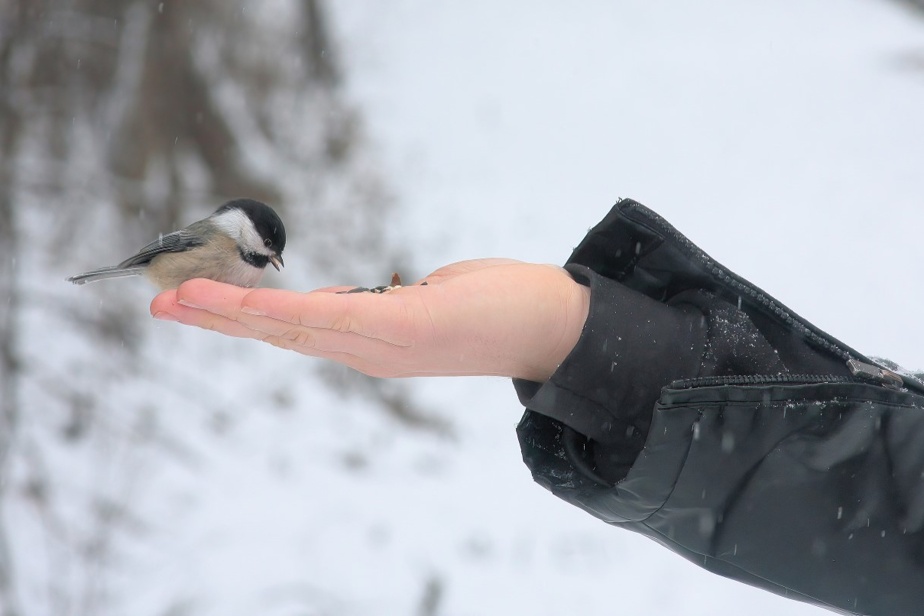The black-capped chickadee is one of our most familiar birds. She lives with us all year round and frequents our feeders regularly.
The black-capped chickadee is very hyperactive.
At the manger, his comings and goings are incessant. In a fraction of a second, she picks a seed to go and dissect her modest feast never far away and return quickly, an aerial ballet always performed in a group during the winter.
It must be said that at -15°C or -20°C, the little tuft of feathers weighing barely 10 grams can hardly do otherwise. She must eat from morning to evening, especially since in the cold season, the nights are long.
She also sleeps alone in the crevice of a tree and, a miracle of evolution, her body temperature can then drop by ten degrees, an energy saving that ensures her survival.

PHOTO WILL MAJOROS, WIKIMEDIA COMMONS
Tiny, the black-capped chickadee owes its survival to its great adaptation to the cold climate of Canada and the northern United States. For example, its legs have special muscles that allow it to pick its food upside down if necessary.
Speaking of adaptation, the muscles of its legs are particularly developed, so that it is upside down that it often picks insects and seeds from the branches. Food being much rarer in winter, she also deposits victuals in thousands of caches during the fall, always only one element per hiding place, treasures which she then locates at the opportune moment, even avoiding places already visited to save energy again.
A growing population
The Black-capped Chickadee is one of the most widespread species in Canada and the northern United States, and the most frequent at feeding stations. Moreover, if a host of birds have been in decline for a few decades, such as swallows and even the house sparrow, its population has doubled from 1990 to 2014, tells us the latest Quebec Breeding Bird Atlas. The situation is due in part to the very large number of feeders available.

PHOTO ANDRIK LANGFIELD, WIKIMEDIA COMMONS
Not very shy, the black-capped chickadee will not hesitate to eat from your hand, for a second or two, to pick a black sunflower seed.
The social life of the small sparrow is subject to a rigid hierarchy, especially in winter when the birds evolve in small groups. Males dominate females (both are identical) and older birds, younger ones. At the mangers, some always give way to others. Dominant pairs normally settle in a larger territory, have better access to food, produce more young and have a higher survival rate. Which perhaps explains why the divorce rate is relatively low… Only about fifteen cases during a study carried out over several years on 94 couples!

PHOTO COURTNEY CELLEY, WIKIMEDIA COMMONS
The chickadee rubs shoulders with several birds of different species at the feeders, notably the northern cardinal and the dark-eyed junco, as is the case here. But a single cry of alarm will succeed in putting all these little people on the alert.
More solitary during the reproduction period, the tit nests in a cavity often dug in rotten wood, producing one brood per year of about four to five young, the male feeding the female during the incubation of a dozen days. The summer diet consists almost exclusively of insects in one form or another, while in the winter half of the food is plant-based.
The young reproduce at 1 year. There again, they can hardly do otherwise, to maintain the population. It is that the predators are numerous, in particular the small birds of prey. In the nest, offspring are often at the top of the menu for squirrels and raccoons. But the little ball of energy nevertheless has a longevity of just over 2 years and one individual has even already reached the phenomenal age of 11 years and 8 months. He had been banded in New York State in 2009 and recaptured and released in 2021.
Cozy nest boxes
The musical vocabulary of the chickadee includes about fifteen variants and its sweet spring melody should be heard soon. Its alarm calls have an immediate effect on the other species it encounters, such as woodpeckers, nuthatches or sparrows. Not very shy, it lets itself be approached easily when it frequents a feeder. With a little patience, she will even eat the black sunflower from your hand, which she particularly likes. Besides, she will also drink regularly at the birdbath, but will rarely linger to soak herself there. The black-capped chickadee does not disdain to live with us either if it has a nesting box that we have taken care to line with fine wood shavings or even sawdust.
